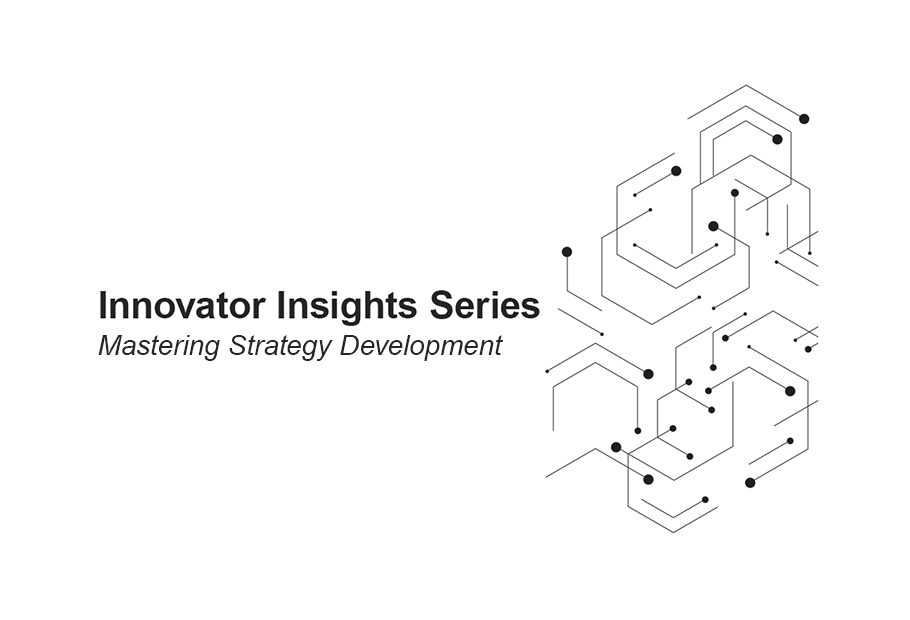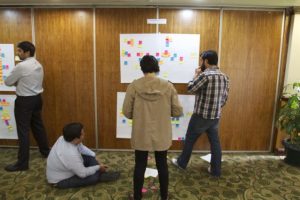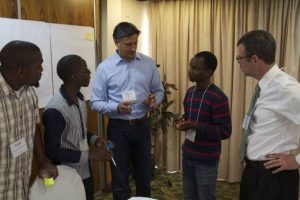
On paper, PharmaChk had a brilliant idea to solve a very devastating problem – fake or substandard medicines claim the lives of hundreds of thousands of people around the world each year. The Boston University-based startup developed a user-friendly, accurate, and portable system that screens for poor-quality medicines by quantifying active pharmaceutical ingredient content.
But when the team began exploring how to bring the innovation to market, they realized their initial assumptions around customers and business strategy didn’t translate as well as they thought in the real world.
PharmaChk manager, Katie Clifford explains that before participating in the Saving Lives at Birth Xcelerator program, “we were convinced that our only customers would be country-specific regulatory agencies. In fact, our entire business strategy was focused on working with the FDAs of the world. After brainstorming other potential customers during the program, we realized that pharmaceutical companies may also be interested in our innovation. Since the program, we’ve engaged with three different global pharma companies interested in protection of their brand.”
As a result of fine-tuning their overall strategy, PharmaChk is now on track to create a sustainable business that will help prevent fake or substandard drugs from affecting more lives around the world. The team received several grants and awards that allow them to continue their work, including a $2 million “transition-to-scale” grant from Saving Lives at Birth: A Grand Challenge for Development.
Why It’s Right to be Wrong
As we described in the first installment of the Innovator Insights Series, all early-stage innovators will encounter challenging hurdles, including not knowing what they don’t know. The innovation journey is about discovery. That discovery process involves seeking clarity from the start, trying to uncover the unknown.
We know that innovators who embrace the challenging process of discovering whether their initial ideas and plans are off the mark ultimately create a stronger strategic direction for their innovation. “A key aspect of strategy development is challenging assumptions about your idea, target market, even innovation design,” said Cara Barnes, VentureWell program officer and Xcelerator program coach. “In the early stages, it’s important for innovators to constantly question ideas and assumptions. Always assume you’re wrong until proven otherwise. Continual questioning, evaluating, and learning will ultimately lead to a more solid strategy for your innovation and business.”
Xcelerator program participants echo Barnes’ sentiments. Challenging assumptions is a critical component of the program. After the Xcelerator in-person workshop, three quarters of the participants made changes to their strategy. Clifford can attest to the importance of workshopping a strategy in its earliest phase.“The Xcelerator program forced us to question things such as our value proposition and business model. The program not only showed us weak points in our plans or ideas, but why. Overall, the process expanded our view on several levels, which led to a more realistic and promising strategy for our company.”
In this final installment of the Innovator Insights Series, we examine key elements of a strategy development process including identifying unknown variables around a target market, revisiting plans and challenging assumptions, and maximizing the impact of ‘aha! moments’.
We spoke with these Saving Lives at Birth innovator-entrepreneurs, coaches, and experts involved with the Xcelerator program about strategy development:
- Katie Clifford of PharmaChk
- Donna Brezinski of Little Sparrows Technologies
- José Nuño of Unima
- Ibrahim Mohedas of SubQ Assist
- Katie Kirsch of Sisu Global Health
- Agostinho Almeida, Xcelerator innovation expert
- Cara Barnes from VentureWell
Identify Unknown Variables Around a Target Market
Innovators and innovation experts alike agree that one of the most important steps early-stage innovators need to take when developing a strategy is to understand the market for their innovation before diving into the deep end of the commercialization process. However, they often don’t know the different variables around entering a target market.

Identifying what you don’t know about a target market is a critical step, especially for early-stage innovator teams who are typically engaged and focused on the scientific, academic, and technological design and implications of their innovation. They often have limited experience with the business side of driving their innovation to market. Innovators who lack awareness about the details of a target market need to embrace the inherent learning curve of this process – and develop a mindset that’s suited for navigating a gray area. Innovation coach Agostinho Almeida describes learning about the market for your innovation as a matter of curiosity. “You need to stay curious when identifying unknown variables about your target market. Keep asking questions to gather as much information as possible.” Innovators who take shortcuts during this process miss out on gathering important information about their target market that will ultimately inform their strategy. Clifford illustrated issues startups face when they don’t fully understand market needs: “We didn’t do an extensive market analysis in the beginning and had a narrow vision of who the customer for our product would be. The more we researched, the more we realized the distinct needs of our segmented market. Hindsight being 20/20, we should have done more analysis about potential customers early on.”
This point is made more complex in global health because the “market” is not clearly defined for the innovator. Many early-stage innovators have to identify all unknown variables in a market, which helps them define the market relative to their product in order to make the case for its value. So how a team defines their market requires a nimble, flexible stance and an assumption that the market has a wide array of variables in play, some of which are not obvious in the beginning.
Ibrahim Mohedas of SubQ Assist further illustrates the complexity and importance of identifying unknown variables in a market sooner rather than later. “Our lab is obsessed with defining needs at the end-user level, but when you think about a successful commercial project you have to think about the need as well as the demand at all levels, at the Ministry of Health, the distributor, regulators, manufacturers – all of their needs and demands have to align for a product to be successful. We didn’t go the extra mile to define all of the variables in our market. The design got much further than the business side, and that was to our detriment.”
Revisit Plans and Challenge Assumptions
Once target market variables are identified, it’s important to validate assumptions made before or after the discovery phase. Innovators can revisit assumptions by engaging with various players and stakeholders in the target market. This pushes innovator teams to develop new perspectives they hadn’t considered before, or confirm or negate findings from their discovery phase.

Innovators will not always like the feedback they receive, since it may require them to go back to the drawing board. But that’s the goal of revisiting plans and challenging assumptions – to fail early and fail fast in order to get on the right track. Innovator José Nuño of Unima recommends embracing the process of challenging assumptions because learning from failure is a key factor of success. “Always discuss your idea with potential customers and people outside your company – especially with those who can give you a negative review. If you take a risk and you don’t win you’ve still learned a lot. And learning is one of the most important things an entrepreneur can do. Be willing to learn and to learn from failure. If you’re not failing, you’re not taking the risks you need to be in a position to be successful.”
Xcelerator teams vary widely in how and in which areas they refine their assumptions. One participant commented about how the program impacted their choice of target user: “We shifted our focus toward early adopters, making sure we interact with potential end users and in-country partners for distribution earlier than we initially anticipated.” Another innovator found clarity around their idea: “The strategic mapping helped us outline the flow of activities and stakeholder participation in the innovation. Matching the benefits to features or attributes of a design clarified the value of reverse designing.” While another participant talked of changing the vision of their work: “I will now be much more focused on patenting and having the material going into business rather than thinking just about publications and academic activities.”
Innovation veterans are quick to acknowledge some of the barriers to their efforts to help teams question their basic assumptions. They note that asking hard questions about accepted assumptions is especially challenging for the people involved in early-stage innovation. As Clifford explained, “As scientists, we understand the facts and the technological complexity of our innovation, but often need support in developing the strategic pathway that’s required for success.”
Even when questioning assumptions can feel like questioning the basic legitimacy of a venture, the outcomes are usually worthwhile. As Clifford continued, “You’re going to get a lot of questions that may have been in the back of your head that are uncomfortable to hear others ask. You have this idea about who you would sell to and who would use your innovation, but it’s worth thinking about alternatives. So it’s about keeping an open mind during this process.”
Maximize the Impact of Aha! Moments

Learning what you don’t know and questioning your assumptions are the stepping stones for moving your innovation forward. These steps provide the source materials for the ‘aha! moments’ that lead teams to critical strategic pivots. Based on key findings during the discovery and validation phases, Brezinski encourages early-stage innovators to make the most of unexpected learnings – even if they’re difficult to process. “Don’t be afraid to pivot away from something that’s not working.”
According to Almeida, ‘aha! moments’ are most effective when innovators are open to act on the new information. “Some people are not ready to change the way they’re looking at things. That willingness is important to help capitalize on the new information.” Almeida is also sympathetic to the difficulties of knowing how and when to pivot based on new findings. “Identifying what you’re doing wrong is not easy. But you need to keep pushing forward. That means being able to communicate, talking to the right people, and analyzing what you’re learning. That’s what feeds your ability to pivot.”
According to Barnes, innovators benefit from attending training programs with an open-minded, relentless, laser-focused pursuit of breakthrough moments – even if the findings come from left field. “When you go into the unknown, expect surprises. Things may not turn out as expected, but that doesn’t mean you’ve failed. Leverage that unexpected information. Work with coaches and mentors during the program to identify the most logical next steps. Breakthrough discoveries aren’t always comfortable, but stagnation can be more detrimental to an early-stage innovator team than a disruptive discovery. They provide the information and motivation to help develop an ideal strategy.”
Our data suggest that early-stage teams benefit from drawing upon outside sources and structures like the Xcelerator program for Saving Lives at Birth innovators to counter what may often be a previously exclusive focus on scientific and technological development. Innovation may build on technological invention, but it only gains traction through strategic thinking, analysis, and action relative to commercial markets. As innovator Katie Kirsch of Sisu Global Health explains, “It’s crucial to think about how your product will sell in a market, or how the product will end up in a person’s hands. In the engineering world, there’s the idea that if it’s a good enough product it will fly off the shelf. It’s important to know that the development is important, but how it will get to people is a bigger challenge and harder to achieve.”
Early-stage innovators do well when they anticipate that they may be out of their comfort zone when it comes to strategy development. Through team collaboration and mentoring from experts, innovators have the chance to step back from the technical dimension of their work and develop eyes for the big picture of global markets, which can catalyze their drive to change the lives and wellbeing of people in all corners of the world.
Time Well Spent: Balancing Action with Introspection
Taking a step back can often help you make the right next step forward. That’s a common theme that we’ve stressed throughout the Innovator Insights Series. While early-stage innovators are often expected to act fast, learn fast, even fail fast during every phase of their journey, many benefit from taking the time to collect their thoughts to help make wise next-step decisions regarding their idea, innovation, or venture.
Here are the five areas we highlighted throughout the series:
- Develop self-reflection skills and foster an entrepreneurial mindset
- Stay coachable when working with experts and mentors
- Take the time to identify skills gaps on a team
- Foster strategic partnerships and relationships with local stakeholders
- Challenge assumptions to help develop a solid strategy
As illustrated in the first installment of the series, self-reflection and fostering an entrepreneurial mindset are both critical factors that contribute to an innovator’s successful launch of their journey. For instance, venturing into the realm of innovation and entrepreneurship can quickly confirm what they already know of their own strengths and weaknesses, while also allowing innovators to discover new things about themselves. But discovering these qualities before facing a critical hurdle on their journey is ideal. That’s why it’s important to reflect on inner motivations and strengths and weaknesses to provide greater clarity around the best direction to consider.
In the same vein, we note that technical skills are a given when developing an invention, but an entrepreneurial mindset – a set of attitudes, skills, and behaviors – is essential for innovators working to transform an idea into a business. Regardless of the chosen commercialization pathway, the earlier innovators develop and hone aspects of this mindset, the more likely they are to succeed. Learning to modulate skills and attitudes in response to particular circumstances, contexts, and goals is equally important.
We highlight the value of coaches, mentors, and trainers for early-stage innovators in the second installment of the series. A key finding from interviews with expert coaches revealed that innovators need to be coachable in order to get the most out of the expertise of mentors and trainers. That means innovators benefit from pausing long enough to be open to new ideas or seek out more information.
In the third installment, we address the need for early-stage innovators building a team to find a mix of scientific and technical talent as well as commercialization skills and business acumen. A critical part of the team-building phase includes taking the time to identify skills gaps on a team or think about the types of individuals to fill a particular role. Programs like Xcelerator can also provide innovators with the necessary space to develop strategic goals as a team, and tap into expert advice as they work through ideas and plans.
We explored in the fourth installment several reasons why it’s important for innovators to understand regional context when developing and launching an innovation in a foreign country. Based on interviews with innovators, many found that taking the time to foster strategic partnerships and relationships with local stakeholders and gatekeepers in healthcare settings, regulatory agencies, and government bodies was critical to their success.
Finally, as discussed above, spending time challenging assumptions is a valuable exercise in developing a solid strategy for a new venture – even if questioning assumptions can feel like questioning the basic legitimacy of an idea. More often than not, it’s time well spent.
As any inventor-entrepreneur can attest, solving enormous challenges through invention is a monumental undertaking in and of itself. It requires answering tough questions to complex scenarios. One wrong decision can be detrimental to vulnerable startups. Innovators who are best equipped to navigate the gray area of an innovation and entrepreneurship journey not only have access to best practices, lessons learned, and expert advice, they have the acuity to know how – and when – to tap into those resources at the right time.
Following this series will be a report that synthesizes our findings within the themes examined in the five Innovator Insights articles.
The Xcelerator program and the Innovator Insights Series are made possible by USAID’s Center for Accelerating Innovation and Impact, The Lemelson Foundation, and The Bill and Melinda Gates Foundation.
Other Installments in the Innovator Insights Series
Preparing for the Innovation and Entrepreneurship Journey